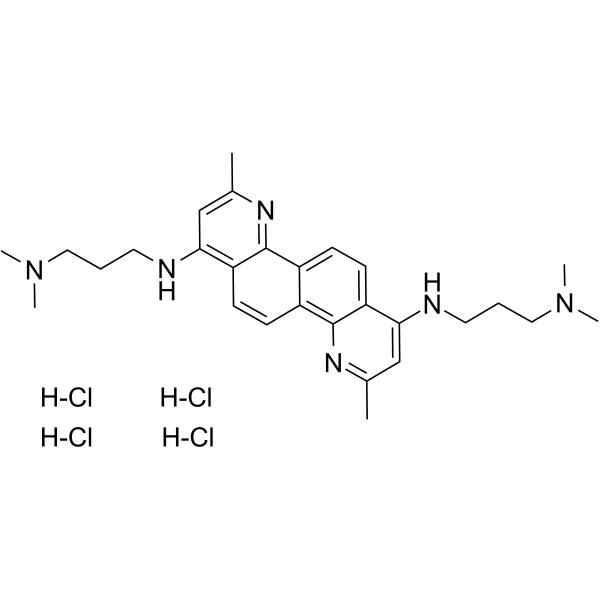
FGI-106 tetrahydrochloride
CAS No. 1149348-10-6
FGI-106 tetrahydrochloride( —— )
Catalog No. M26214 CAS No. 1149348-10-6
FGI-106 tetrahydrochloride is active against Ebola, Rift Valley and Dengue Fever viruses with EC50s of 100 nM, 800 nM and 400-900 nM, respectively.
Purity : >98% (HPLC)
 COA
COA
 Datasheet
Datasheet
 HNMR
HNMR
 HPLC
HPLC
 MSDS
MSDS
 Handing Instructions
Handing Instructions
| Size | Price / USD | Stock | Quantity |
| 5MG | 260 | Get Quote |


|
| 10MG | 410 | Get Quote |


|
| 25MG | 678 | Get Quote |


|
| 50MG | 954 | Get Quote |


|
| 100MG | 1287 | Get Quote |


|
| 200MG | Get Quote | Get Quote |


|
| 500MG | Get Quote | Get Quote |


|
| 1G | Get Quote | Get Quote |


|
Biological Information
-
Product NameFGI-106 tetrahydrochloride
-
NoteResearch use only, not for human use.
-
Brief DescriptionFGI-106 tetrahydrochloride is active against Ebola, Rift Valley and Dengue Fever viruses with EC50s of 100 nM, 800 nM and 400-900 nM, respectively.
-
DescriptionFGI-106 tetrahydrochloride is active against Ebola, Rift Valley and Dengue Fever viruses with EC50s of 100 nM, 800 nM and 400-900 nM, respectively. FGI-106 tetrahydrochloride also inhibits non-hemorrhagic fever viruses HCV and HIV-1 with EC50s of 200 nM and 150 nM, respectively. FGI-106 tetrahydrochloride is a potent and broad-spectrum inhibitor with inhibitory activity against multiple viruses.(In Vitro):In cell-based assays, treatment with FGI-106 inhibits viral replication by divergent virus families, including positive and negative-strand RNA viruses.Treatment with 2 μM FGI-106 mediated a 4 log reduction in infectious viral titers relative to matched controls, with an EC90 for inhibition of viral killing of host cells (Vero E6 cells) estimated to be 0.6 μM. (In Vivo):FGI-106 treatment decreases mortality from Zaire EBOV in a dose-dependent manner.
-
In VitroTreatment with 2 μM FGI-106 mediated a 4 log reduction in infectious viral titers relative to matched controls, with an EC90 for inhibition of viral killing of host cells (Vero E6 cells) estimated to be 0.6 μM.In cell-based assays, treatment with FGI-106 inhibits viral replication by divergent virus families, including positive and negative-strand RNA viruses.
-
In VivoFGI-106 (0.1-5 mg/kg; intraperitoneal injection; treatments on days 2 and 5; C57BL/6 or BALB/c mice) treatment decreases mortality from Zaire EBOV in a dose-dependent manner. Animal Model:Male or female C57BL/6 or BALB/c mice (6-10 weeks of age) injected with EBOV (Ebola virus) Dosage:0.1 mg/kg, 0.5 mg/kg, 1 mg/kg, 2 mg/kg, 5 mg/kg Administration:Intraperitoneal injection; treatments on days 2 and 5Result:Decreased mortality from Zaire EBOV in a dose-dependent manner.
-
Synonyms——
-
PathwayOthers
-
TargetOther Targets
-
Recptor——
-
Research Area——
-
Indication——
Chemical Information
-
CAS Number1149348-10-6
-
Formula Weight604.49
-
Molecular FormulaC28H42Cl4N6
-
Purity>98% (HPLC)
-
SolubilityIn Vitro:?DMSO : 6.67 mg/mL (11.03 mM)
-
SMILESCl.Cl.Cl.Cl.CN(C)CCCNc1cc(C)nc2c1ccc1c2ccc2c(NCCCN(C)C)cc(C)nc12
-
Chemical Name——
Shipping & Storage Information
-
Storage(-20℃)
-
ShippingWith Ice Pack
-
Stability≥ 2 years
Reference
1.Bodner et al (2006) Pharmacological promotion of inclusion formation:a therapeutic approach for Huntington's and Parksinson's diseases. Proc.Natl.Acad.Sci.USA 103 4246
molnova catalog



related products
-
1,2-Dioleoyl-sn-glyc...
1,2-Dioleoyl-sn-glycero-3-phospho-L-serine sodium can be used in lipid mixtures with DOPC and DOPE as effective nontoxic and nonviral DNA vectors.
-
PCLX-001
PCLX-001 is a small-molecule compound that acts as an orally active inhibitor of N-myristoyltransferase (NMT), specifically targeting NMT1 and NMT2 with IC50 values of 5 nM and 8 nM, respectively.
-
Nur77 modulator 1
Nur77 modulator 1 is a good Nur77 binder (K D = 3.58 μM). Nur77 modulator 1 up-regulates Nur77 expression, mediates sub-cellular localization of Nur77, induces Nur77-dependent ER stress and autophagy, and results in cell apoptosis. Anti-hepatoma activity .



 Cart
Cart
 sales@molnova.com
sales@molnova.com


